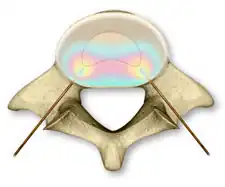Disc biacuplasty
| Disc biacuplasty | |
|---|---|
 Placement of radio frequency-generated heat probes during a disc biacuplasty. | |
| Specialty | orthopedic |
Disk biacuplasty' is a medical procedure that applies heat to the annulus of disks that separate the vertebra of the back with the goal of ablating the neurons that generate pain sensations.[1] The procedure is designed to reduce chronic back pain caused by the intervertebral discs. The procedure is in the early stages of testing[2] with some evidence of efficacy.[3]
As possible advantages to conventional techniques, the developers of the procedure cite its ease of use and a lack of artificial concentric fissures. The procedure may destroy pain nerves without damaging nearby tissues, though evidence for this comes only from studies with cadavers.[1] Testing on pigs suggested it heats the desired area without damaging the dorsal root ganglia or spinal nerve roots, though the cells of the disc demonstrate histological changes.[4]
See also
References
- 1 2 Kapural, Leonardo; Mekhail, N; Kapural, M; Hicks, D. "Histological and temperature studies of a novel transdiscal heating system in human cadaver discs". unpublished conference abstract. San Francisco. Retrieved 2007-12-06.
- ↑ "New radiofrequency technique reduces disc pain with quick recovery time". American College of Radiology. Archived from the original on 2012-02-06. Retrieved 2007-12-06.
- ↑ Kapural L, Mekhail N (2007). "Novel intradiscal biacuplasty (IDB) for the treatment of lumbar discogenic pain". Pain Pract. 7 (2): 130–4. doi:10.1111/j.1533-2500.2007.00120.x. PMID 17559482. S2CID 23626783.
- ↑ Petersohn, J; Conquergood, LR; Leung, M (2007-03-09). "Acute histologic effects and thermal distribution profile of disc biacuplasty using a novel water-cooled bipolar electrode system in an in vivo porcine model". Pain Medicine. 9 (1): 26–32. doi:10.1111/j.1526-4637.2006.00293.x. PMID 18254764.